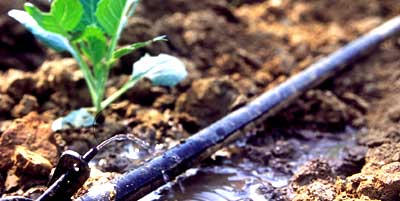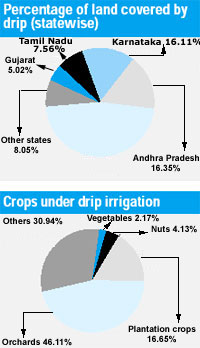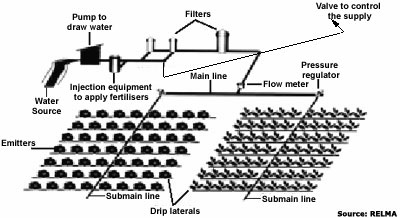Although the majority of farmers in India are small or marginal, the country’s policy, while promoting drip
irrigation, has yet to catch up with this change that might hold the key to alleviating a significant share of rural hunger and poverty. Recurrent droughts and increased competition for scarce water resources has put into bold relief the need to focus on efficient water use. This calls for a re-evaluation of strategies to improve access to water-saving technologies. Examples of innovative adaptations of low cost systems by farmers to suit their needs show that drip technology made simple and flexible can work in ways that are more dynamic and fruitful than any sophisticated technology can. Water provided to crop, not landWhat is drip irrigation? Typically, in canal-irrigated fields in India, water is released during the cropping season. A common method of irrigation is "flood irrigation" where all the water rushes into the field and, guided by channels and the slope of the land, flows along the rows of crops. A lot of this water is lost to evaporation; much of it percolates deep into the soil out of reach of the plant root; and a good percentage is lost even before it reaches the field. Drip irrigation is the solution to recurrent water loss. It is particularly useful in areas that have a low water supply.
Jalinder Jamdani from Manerajauri village in southern Maharashtra is one of the many successful drip farmers in India. His plots are covered by a network of narrow black pipes, each running along a row of grape trees. Every foot or so, drippers fitted into the pipes deliver water to each plant. One large main pipe connected to his well feeds water into these pipes or laterals. This is how drip systems deliver water at low pressures almost directly to the roots of the plants. In an area that is drought-prone and borewells dug to 500 feet yield no water, Jamdani owes his success to using drip irrigation for grape cultivation. Each acre produces about Rs 300,000 — 400,000 worth of export-quality grapes, whose growth, shape and sweetness he attributes to the measured watering of drip irrigation. Jalinder irrigates his 11 acres of grape every day for the required time, giving the plant just enough water to suit its needs and use the precious water he has had to buy from tankers this year a drop at a time. Only that part of the soil immediately surrounding the plant (root zone) is wetted and little water is wasted. When well maintained, application of water by drip irrigation can be as much as 95 per cent efficient. Which means there is very little loss due to evaporation, surface runoff or from percolation. Turning deserts into greeneriesThe development of plastics during World War II and the subsequent availability of inexpensive, weather resistant plastic pipes paved the way for large-scale drip irrigation. The Israelis were the first to develop drip systems for commercial applications. By the late 1960’s, the use of drip expanded rapidly and spread particularly throughout the semi-arid regions of Australia, Israel, New Zealand, Mexico, USA and South Africa, where there was a pressing need to make the most efficient use of limited water supplies. In the 1970s, only about 56,000 ha of land globally was irrigated by drip irrigation. Today, it is estimated to be around 7.8 million ha. The drip tape technology (see timeline) made the development of simple drip irrigation systems for poor farmers considerably easier.
In India, traditional drip irrigation systems, such as bamboo drip in Meghalaya, have been around for centuries. Modern drip irrigation technologies arrived in the 1970s from Israel and the US, where it was optimised for use by big commercial farmers. The government of India, realising the potential of drip, released Rs 11.96 crore to state governments under centrally sponsored schemes between 1982-83 and 1991-92 for the promotion of drip, sprinkler and other water saving irrigation practices. According to the Indian National Committee on Irrigation and Drainage (INCID) about 80 crops are suitable for drip irrigation. found to be very high in sugarcane. A criterion is that they be row-crops rather than closely spaced ones. These cover almost all fruit and vegetable crops, coconut, cotton and even some oilseed crops. Using drip, the amount of water saved is almost doubled.
|
||||||||||||||||||||||||||||||||||||||||||||||||||||||||||||||||




 An ancient
tradition
An ancient
tradition